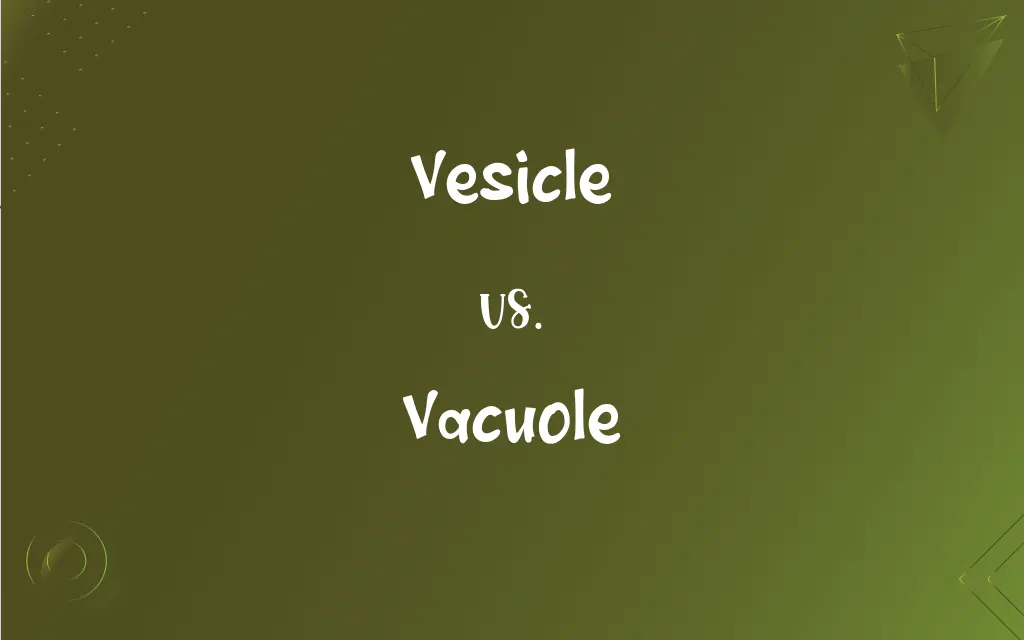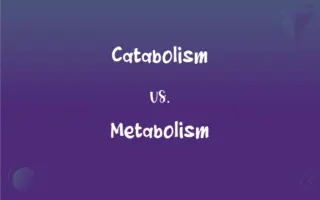Vesicle vs. Vacuole: What's the Difference?
Edited by Aimie Carlson || By Harlon Moss || Updated on October 29, 2023
Vesicles are small membrane-bound sacs for transport within cells; vacuoles are larger, primarily in plants, for storage, waste disposal, and growth.

Key Differences
Vesicle and vacuole are both membrane-bound structures found within cells, playing vital roles in cellular processes. While they share some similarities, such as being enclosed by a lipid bilayer, they have distinct functions and characteristics. A vesicle is generally a small structure that transports substances within a cell, whereas a vacuole is a larger compartment often used for storage and maintaining turgor pressure, especially in plant cells.
In terms of function, vesicles are often involved in the trafficking of molecules. They can transport substances between various compartments within the cell, such as from the endoplasmic reticulum to the Golgi apparatus or from the cell's interior to its exterior. Vacuoles, on the other hand, have a more diverse set of functions, depending on the type of cell. In plant cells, for example, a large central vacuole can occupy up to 80% of the cell's volume, storing nutrients, waste products, and helping to maintain turgidity.
The formation and origin of vesicles and vacuoles also differ. Vesicles can form in several ways, including budding off from the plasma membrane or from internal organelles like the endoplasmic reticulum. These vesicles can then fuse with other membranes to deliver their contents. Vacuoles, especially the large central ones in plant cells, develop from the fusion of smaller vesicles, which originate from the endoplasmic reticulum and the Golgi apparatus.
In animal cells, vesicles play a crucial role in processes like endocytosis (taking in external materials) and exocytosis (expelling materials out of the cell). These vesicles can contain enzymes, neurotransmitters, or other substances. Vacuoles in animal cells, although less prominent than in plant cells, are primarily involved in waste disposal. They can isolate harmful materials and transport them out of the cell or to lysosomes for degradation.
In summary, while both vesicles and vacuoles are essential membrane-bound structures in cells, they serve different functions and have distinct characteristics. Vesicles primarily focus on the transport and delivery of molecules, while vacuoles, depending on the cell type, handle storage, waste management, and turgor maintenance. Recognizing these differences is key to understanding the intricate operations within cells.
ADVERTISEMENT
Comparison Chart
Size
Small membrane-bound sacs.
Larger membrane-bound compartments.
Function
Transport materials within cells.
Storage, waste disposal, maintain pressure.
Formation
Pinching off from larger membranes.
Fusion of multiple vesicles.
Presence in Cell Types
Both animal and plant cells.
Predominantly large in plant cells.
Role
Metabolism, enzyme transport.
Structural support, growth.
ADVERTISEMENT
Vesicle and Vacuole Definitions
Vesicle
A small fluid-filled sac in a cell.
The vesicle transported proteins to different parts of the cell.
Vacuole
Formed by the fusion of smaller vesicles.
Multiple vesicles combined to form the vacuole.
Vesicle
Forms by budding off from membranes.
The vesicle pinched off from the Golgi apparatus.
Vacuole
Involved in waste disposal and storage.
Waste products were isolated in the vacuole.
Vesicle
Can transport both liquids and gases.
Oxygen was transported in a vesicle within the cell.
Vacuole
Helps maintain cell pressure and structure.
The large vacuole kept the plant cell turgid.
Vesicle
Involved in processes like exocytosis.
Neurotransmitters were released from the vesicle.
Vacuole
A large storage compartment in plant cells.
The vacuole stored nutrients for the plant cell.
Vesicle
Plays a role in metabolism and transport within cells.
The enzyme was carried inside a vesicle.
Vacuole
Supports growth and reproduction in plants.
The vacuole played a role in the cell's growth.
Vesicle
(Cytology) A membrane-bound structure within a cell in which materials such as enzymes are transported or stored.
Vacuole
A membrane-bound organelle in the cytoplasm of most cells, especially plant cells, containing water and dissolved substances such as salts, sugars, enzymes, and amino acids.
FAQs
What's the primary function of a vacuole?
Storage, waste disposal, and maintaining pressure.
What's the primary function of a vesicle?
Transporting materials within cells.
Are vesicles present in both animal and plant cells?
Yes, vesicles are present in both.
Are vacuoles essential for plant growth?
Yes, they are crucial for plant cell growth and reproduction.
What is a vesicle?
A vesicle is a small, membrane-bound sac in a cell.
What is a vacuole?
A vacuole is a large storage compartment, mostly in plant cells.
How do vesicles form?
Vesicles form by pinching off from larger membranes.
How do vacuoles form?
Vacuoles form by the fusion of multiple vesicles.
Do vesicles have a role in metabolism?
Yes, vesicles are involved in metabolic processes.
Can vesicles transport enzymes?
Yes, vesicles can transport enzymes within cells.
Can vesicles carry gases?
Yes, vesicles can transport both liquids and gases.
What is the content of vesicles?
Vesicles can contain fluids, nutrients, or waste.
Can vesicles merge with other cell structures?
Yes, vesicles can merge with cell membranes and organelles.
Do vacuoles contain cell waste?
Yes, vacuoles often contain cell waste and byproducts.
Do vacuoles contribute to cell turgidity?
Yes, vacuoles help maintain pressure and turgidity.
Is the size of vacuoles consistent across cell types?
No, vacuoles vary in size, larger in plant cells.
Are vacuoles always single large structures?
Mostly, but some cells can have multiple small vacuoles.
Are vesicles involved in exocytosis?
Yes, vesicles play a role in exocytosis.
Are vacuoles larger in plant or animal cells?
Vacuoles are predominantly larger in plant cells.
What is the role of vacuoles in plant cells?
They provide structural support and play a role in growth.
About Author
Written by
Harlon MossHarlon is a seasoned quality moderator and accomplished content writer for Difference Wiki. An alumnus of the prestigious University of California, he earned his degree in Computer Science. Leveraging his academic background, Harlon brings a meticulous and informed perspective to his work, ensuring content accuracy and excellence.
Edited by
Aimie CarlsonAimie Carlson, holding a master's degree in English literature, is a fervent English language enthusiast. She lends her writing talents to Difference Wiki, a prominent website that specializes in comparisons, offering readers insightful analyses that both captivate and inform.
































































